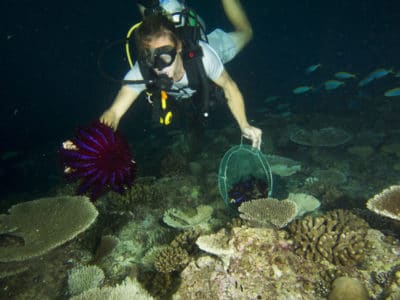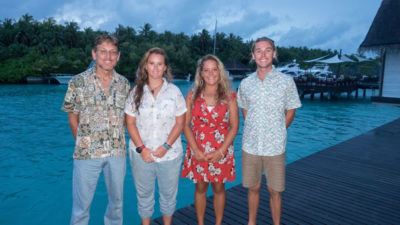Expedition Log: Maldives – Day 18
Over a short three-week period, our team of four scientists collected over 7,500 crown of thorns starfish (COTS) from three locations off North Malé Atoll and South Malé Atoll in the Maldives. While this is but a fraction of the total number of COTS that have emerged on Maldivian reefs since 2013, it represents a huge leap forward for the conservation of their coral reef resources.
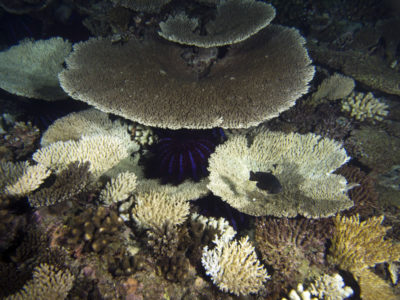
Mix of live and dead table acroporids and a COTS.
In each location where we identified an outbreak, we were able to eliminate the majority of the animals. This typically represented 1,000-1,500 animals from a single, small patch reef. By removing most starfish from a single reef we have prevented the loss of the entire reef system, which has been the typical fate of coral reefs where control efforts were not implemented. The surviving corals serve as the breeding stock to replenish the reef system. The removal of large aggregations of COTS also greatly reduces the potential for future outbreaks, as each animal has the potential to produce 60 million eggs or more in a breeding season. Further, fertilization success of these eggs is much higher when the animals form dense aggregations.

Removal team at Anantara with their COTS bounty.
Successful control of COTS requires a team effort, starting with careful monitoring, observation and reporting of changes in coral reef health, followed by mobilization of certified divers in affected areas to remove the starfish. For our work we relied on other divers, especially the marine biologists and dive center staff, to assist us in removing the COTS. After a short briefing on search patterns for the COTS, and safe, non-destructive removal and collection techniques, each dive team descended onto the reef and began a systematic collection effort.
Each team swam along the reef system at a single depth, with buddy teams spread out down the reef slope from 2-3 m to 25 m. Depending on the size of the reef and the density of the COTS, it could take anything from a single dive to multiple dives and days to remove most of the starfish. After completing one pass around the entire reef, we swam around a second time to collect any animals that we had missed.
During our research we witnessed the consequences of severe outbreaks when steps were not taken to remove the starfish – losses of 80-98% of the coral throughout all depths. We also gained a better understanding of movement patterns of the starfish. Based on patterns of mortality, we could tell where the COTS first invaded the reef and how they had spread. Like a colony of ants searching for food, a few scouts were found within the healthiest part of the reef. Behind this we often found the densest aggregation and the highest amount of recently killed coral – hundreds of white skeletons and hundreds of starfish. Continuing away from the focal point, there was much more dead coral; most of the dead corals had turned brown from colonization of algae and only a few starfish were seen.
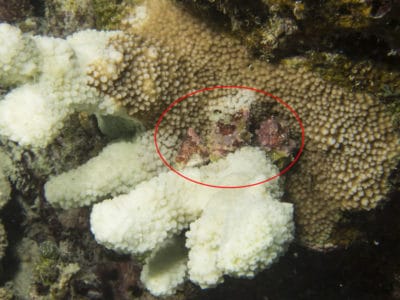
Drupella on remaining acroproid.
If the COTS had been feeding for months, most of the branching corals were already dead, and the remaining starfish were feeding on less preferred species such as massive boulder corals (Porites). At least in South Malé Atoll, however, we had arrived relatively shortly after the starfish first invaded these reefs – most of the long-lived massive boulder corals were still alive and only fast growing branching species had been eaten.
While the long term benefits of the removal of COTS still need to be determined, we have a chance to better understand this by reexamining these reefs next year. As the current El Nino event extends into 2016, the Maldives are under a growing threat of bleaching and coral mortality due to increasing sea water temperatures. By saving corals from COTS predation, we may have given these reefs a chance of surviving the bleaching event. We know that certain corals are more susceptible to bleaching than others. If the starfish were allowed to eat everything on the reef, none of these resistant corals would remain. Now, some of the corals that were saved may survive the bleaching event, and those will serve as the breeding stock to rehabilitate the coral reefs once the bleaching event passes.
Through our research we are also interested in understanding the origins of these outbreaks and the patterns of spread. We still do not know if the emergence of COTS on different atolls represents starfish that originated at the original epicenter of the outbreak (the west side of North Malé Atoll) or if they are all separate events. Our collections of tube feet will allow us to unravel this detail. These genetic samples will provide data to determine whether all starfish are from the same cohort or they represent discrete populations. By understanding this, we would be better able to develop strategies to prevent outbreaks in the future.
Education is an extremely important component of conservation. At each resort we worked closely with their staff to answer questions on our research and COTS ecology and removal techniques. At Anantara Resort, we also ran several presentations for guests and staff and were able to reach over 150 people, teaching them about coral reefs, the biology of crown of thorns starfish, their impacts, and measures that can be taken to minimize their impacts.
The success of this mission would not have been possible without all of the generous support and enthusiasm of our sponsors and individuals. We would firstly like to thank Gili Lankanfushi and One & Only Reethi Rah Resorts and their Managers for their support and contributions and for allowing us to visit their beautiful resorts and work alongside their staff. We worked closely with three marine biologists at these resorts, Deborah Burn, Josie Chandler and Kylie Merritt. Having extra hands to help on the boats, in the water and hunting for COTS was critical to this mission.
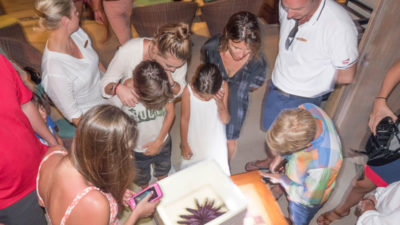
Looking at a starfish during a guest lecture.
We also would like to thank Anantara Resort and their General Manager, Torsten Richter, they made us feel like family from the start and the enthusiasm and willingness of all their staff from dive masters to restaurant managers to get in the water and help was overwhelming. A special mention for Liz Smailes, who worked with us during our stay and without her organizational skills and all of her help- we would never have achieved such a great success at this resort. Throughout our time at each resort we worked closely with the staff and diving center teams at Anantara, including Marta Rigo, Alba Bustillo, and Joseph Lassus. We taught these teams safe practices for COTS removal, and educated them on how to best manage their outbreaks. We hope that these resorts now have the knowledge and encouragement to continue running regular dives to affected reefs to remove all COTS and prevent further destruction to their coral reefs.
The future of Maldives reefs is bright, but it depends on continued diligence of all Maldivians to control COTS, efforts to minimize human impacts, and expanded education, outreach, training and in water support to monitor and manage these precious resources. The Marine Research Centre, within the Ministry of Fisheries and Agriculture collaborated with us in our efforts to understand and address COTS, and has a strong conservation mission and dedicated program to document the reefs and reef threats, educate stakeholder and implement key conservation measures. We plan to revisit the precious coral reefs of the Maldives in 2016, to better understand the outcomes of our COTS control efforts and benefits these mitigation efforts have in minimizing losses from other disturbances, especially the predicted 2016 bleaching event.
Photos by Andrew Bruckner
